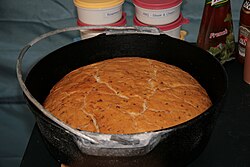 Potbrood in the pot | |
| Type | Bread |
|---|---|
| Place of origin | South Africa |
Potbrood ("pot bread") is bread first made by the Boer settlers of what is now South Africa. Potbrood was traditionally baked in a cast-iron pot (also known as a Dutch oven) in a pit made in the ground and lined with hot coals.
Potbrood is often made at a braai (barbecue) by packing charcoal or wood coals around a cooking pot. [1]